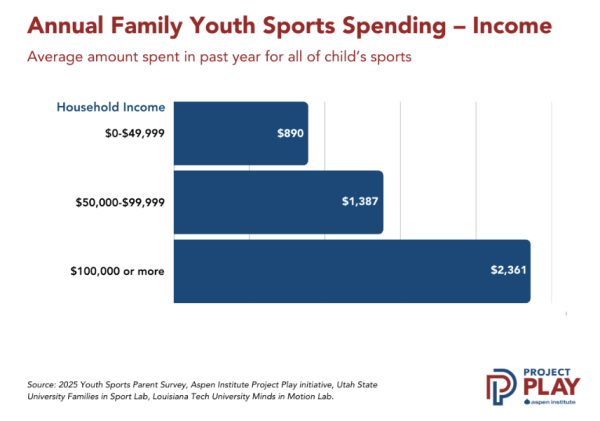“Money makes the world go round.” But is there such a thing as too much money? If you asked the sports industry, they would respond with a resounding “NO!”. That is to say, at this point, it seems as though every single organization having to do with sports is just farming money. Recently, ESPN acquired NFL Network and the rights to NFL Redzone, in return for the NFL receiving a stake in the popular sports network. NFL Redzone has long prided itself on being a subscription network where fans can pay $10 a month to receive “7 hours of commercial-free football”. It successfully, from 2009 to 2024, delivered on its promise. However, the network recently announced that it would be introducing commercials during the day-long broadcast. That was a sad moment for sports fans across the country.
Now, let’s take a look at college football. Over the past couple of months, the Big 10 conference commissioner, Tony Petitti, has been advocating for an expanded playoff with autobids for every conference’s top teams. His goal is to make a weekend of exciting play-in games between top conference teams to determine who gets to make the playoffs. People unfamiliar with the unique sport that is college football may think, “Well, what could be bad about that? More exciting games for everybody, where the energy is high and the stakes are even higher.” However, if conference standings are the rankings that affect conference play-in games, then what happens to non-conference games? Teams would have no incentive to play out-of-conference games like those we just saw over the past few weeks: Ohio State vs. Texas, Miami (FL) vs. Notre Dame, Clemson vs. LSU, Oklahoma vs. Michigan. Games like these would be mere “exhibition” games that do not affect a team’s playoff hopes. Not only that, but a team would only need to finish in the top 6-8 teams in the conference to make a play-in game and have a shot at the playoffs. Teams could lose 3-4 games and still make the playoffs. In the days of BCS, or the 4-team College Football Playoffs, teams would have to be near perfect, losing one game max, to make the playoffs/championship game. Now, you may be wondering, “Why is this guy yapping about all this in a story about how money is ruining sports?” That’s where the motive comes in for holding these play-in games: money. The Big 10 is an exclusive partners with FOX to broadcast their games. Play-in games with higher stakes equals more viewership equals more money lining the pockets of FOX and Pettiti. So, there you have it. Money is ruining the sports that millions of Americans watch every single weekend.
Is it completely out of the realm of possibility that money is actually helpful for college football? Not exactly. Lots of college football fans argue that NIL is tearing apart the sport, causing players to leave small schools chasing a bigger payday. I would argue that the thing that most fans think about when they make that argument is the transfer portal. With no penalty for transferring between schools, all the players who were found as 2 stars develop at a Group of 5 school, then transfer to a big school for money. If NIL didn’t exist, they would still transfer for better opportunities, so NIL isn’t leading the charge to leave small schools. NIL is simply leveling the playing field. Before NIL, the things that attracted players were name brands and reputations. If you’re a school without a national championship, good luck attracting 4 and 5 stars. Why would a good recruit pick your school? Now, money is attractive to players. It evens the playing field as schools that don’t have a history of national championships, like Michigan, Alabama, or Notre Dame, can attract top recruits. For example, Oregon has never won a national championship. However, for the past few years, they have been really good because they can level the playing field with the historic schools. However, at the end of the day, I think money is ruining college football more than it is helping.
Don’t stop reading yet, because we’re not done. Up to this point, I’ve described how money is ruining professional and semi-professional sports. One could argue that that is to be expected, simply because they exist to make money. But nobody would think to look to the one place where sports flourish, where players play for the love of the game: youth sports.
They go by many names, but they’re all the same at heart. They are places for kids ages 5-12 to develop and hone their love of play in a safe, supportive environment. According to projectplay.org, participation by children ages 6-12 has been down in recent years, compared to the 2010s. According to jerseywatch.com, youth sports have increased in cost recently due to several reasons: “The high cost of youth sports has grown due to more professionalization, more specialized training, travel expenses, and equipment. Private coaching, elite leagues, and year-round participation have also increased costs”.
Take a look at this graph from the Aspen Institute Project Play Initiative:

Higher-income families, on average, spend more on youth sports than lower-income families. Looking at the graph, we can see that higher-income families and children have an advantage by spending more on sports than lower-income families, essentially cutting out a large portion of the population from youth sports. The push of youth sports toward clubs hurts people who aren’t specializing in sports from a young age, which is extremely expensive to do so. These kids are faced with the harsh reality of middle school sports not having enough spots for those who haven’t been playing since they could walk. Not only that, but being exposed to a wide variety of sports is an integral part of childhood. Sports bring out our best and worst selves and force us out of our comfort zones. Participating in a multitude of different sports that challenge us in different ways forces us to develop in those ways, yet it is slowly becoming less possible to feasibly compete in multiple sports without being the next LeBron James.
Sources
- https://www.espn.com/espn/story/_/id/45910378/espn-get-nfl-network-rights-redzone-nfl-equity-stake
- https://projectplay.org/state-of-play-2022/participation-trends#:~:text=Only%2037%25%20of%20children%20ages%206%2D12%20played,the%20Sports%20&%20Fitness%20Industry%20Association%20(SFIA).
- https://www.jerseywatch.com/blog/costs-of-youth-sports



